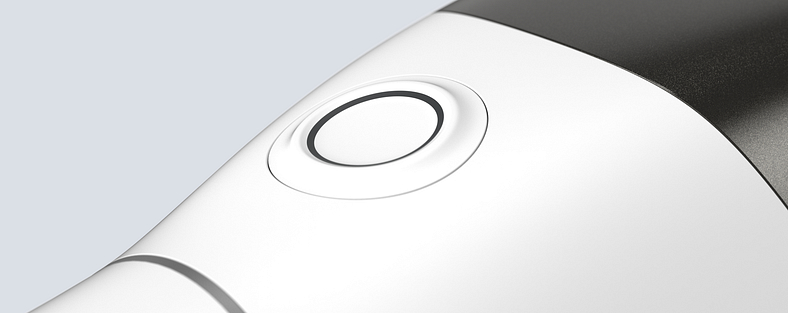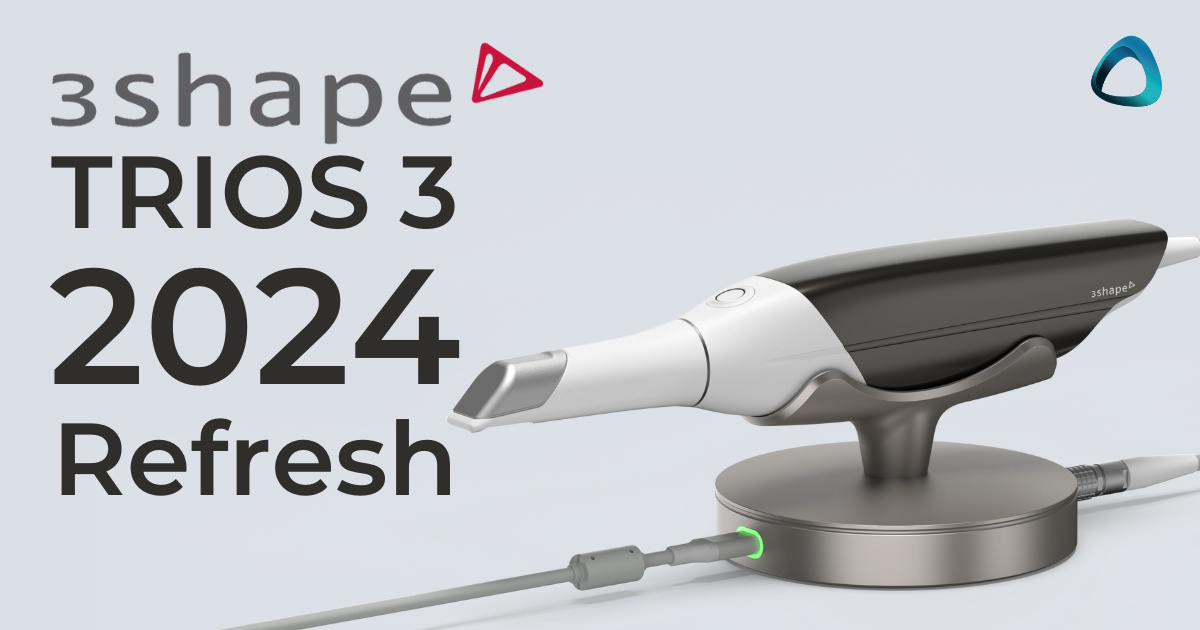It’s been a pretty big week for 3Shape. At their Discover event, the company announced four really exciting releases.
You can check them all out in our recap blog here, but in this article, we’ll deep-dive into the updated TRIOS 3 and see how it differs to the older version TRIOS 3.
So, what’s new and why exactly was this released? Let’s get into it.
We've made a quick video breaking down the updates, but if you'd like more in-depth info, keep reading!
What’s New with the Updated TRIOS 3 Intraoral Scanner?
So, what’s new with this TRIOS 3?
Well, it is the same TRIOS 3 scanner. Now just with some quality of life improvements.
Most strinkingly and obvious, is that it has has a totally refreshed body color now - what the company calls Twilight Titanium. Not going to lie, it looks pretty cool. There seems to be some trend with titanium going on.
There is also a metal ring near where the scanner tip connects. This is again purely aesthetic. All TRIOS scanners now have a 'ring' with the TRIOS 5 being LED and functional.

Apart from the color, most noticeably, we have an updated scanner button. It is slightly raised and more of a button rather than the silicone the company has used with the older TRIOS 3s. This also makes it easier to clean.

We also have an updated vent at the back to improve cooling.
And that is basically it for the scanner update. It is the exact same hardware inside as the older TRIOS 3 models.

This is still a TRIOS 3, but it has been updated a bit to make it more modern. It still weighs 340 grams like the previous TRIOS 3 and is a wired scanner with a 1.5m cord. It uses the same TRIOS 3 tips, which you get 5 of in the box, and can be autoclaved 150 times. It has the same TRIOS 3 calibration kit, dongles, etc., and all the hardware is the same as before.


The updated TRIOS 3 will cost 16.900 € / 17,400 USD.
And the scanning tips can be bought as a box of 3 for 450 €/USD.
Interestingly, this new TRIOS 3 is not coming in a wireless version. So in the TRIOS portfolio, TRIOS Core and 3 are now wired and TRIOS 4 and 5 are wireless.
Changes to The TRIOS 3 Pod
The most significant hardware change is not with the scanner itself but actually the pod. This new pod looks a lot better.
It has this metallic design but more importantly it is smaller than the previous generation pod by 10% and 30% lighter at 510 grams. This is actually really useful as the older TRIOS 3 pod was quite bulky.


There’s an LED light that lights up green to let you know everything is connected properly.
And my personal favourite new feature - it is now totally USB-C powered!

The best update in my opinion to the new TRIOS 3 is that everything is USB C powered. Yes you still need a pod, which I would have preferred not to, being directly to computer would have been nice, but at least now its one connection, one wire, to the laptop and that is it.
I personally found it annoying to always have to plug in my old TRIOS 3 pod into the wall and now that it is just powered by USB-C - this is much better.
So, this is the TRIOS 3 that will be produced going forward. The older units are no longer going to be manufactured, but you may still see them being sold until the current supply is used.
The Era of TRIOS 3 continues with this nice facelift and quality-of-life improvements.
Why Did 3Shape Update the TRIOS 3 Intraoral Scanner?
So the question everyone wants to know - why did 3Shape update this scanner?
Why release an updated TRIOS 3 at the same price, €16,900 or around $17,000 USD, if they just released the TRIOS Core, which is the newest scanner and lowest-cost option?
2 main things:
1) TRIOS 3 is trusted. The tech has been around for over 9 years. In that time we have seen many research papers - over 200 - proving the accuracy of this scanner, and frankly it is just trusted by thousands of dentists who use it.
I still personally use my TRIOS 3 from time and time and can attest to this. It’s a great scanner that is proven. Why change something that is not broken?
2) Most importantly, however, and this holds a ton of value – is that TRIOS 3 is STILL accepted by Invisalign.
No other TRIOS scanner is and apart from Omnicam which isn’t really ideal for full arch aligner scanning, it is either TRIOS 3 or iTero. Basically, this is the only other scanner you should consider for Invisalign apart from iTero as it still has the valuable Invisalign connection – except if you work in North America, China and Japan, where it’s not accepted.
This single factor is so valuable that it is genius that the company relaunched this product with a more modern look and quality-of-life benefits rather than discontinuing it outright.
So that’s it. This is the updated TRIOS 3 from 3Shape. It is the same excellent scanner many of us are used to, but with an updated design to keep it in line with the current market.
Let me know what you think in the comments below.


Eu sou o Dr Nilson Tolazzi de Goiânia, Brasil, e adquiri meu Trios 3 agora em janeiro /2025 para o meu consultório particular, estava usando o Heron IOS e estou fazendo esse Up Grade devido aos Softwares que o Trios 3 me oferece, e assim quero planejar meus casos clínicos com mais tecnologia e precisão nos resultados clínicos, estou muito confiante e sei que adquiri o melhor Scanner Intra Oral do mundo.
Hey Doc. Congratulations. TRIOS 3 is a fantastic scanner and I am sure you will love it.